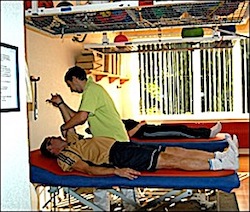Bobath Concept
In the Bobath method, the following three elements are combined in a way best suited to achieving the patient's therapeutic objectives.
Inhibition:
the inhibition of abnormal tone and movement patterns in order to create a better basis for more normal active movements.
Facilitation:
the facilitation of normal physiological kinetic patterns.
Stimulation:
a variety of techniques and measures are used to prepare and initiate movements that have a direct effect on the somatic body senses. The distinction is made between inhibitory and facilitatory stimulation in the various clinical disorders, such as hemiplegia, apoplectic insult (stroke), multiple sclerosis, Parkinson's disease and other (disorders of the reciprocal innervation mechanism). Patients suffering from these disorders may present with no voluntary movement or maladjusted movement patterns due to simultaneous agonist-antagonist inhibition or simultaneous agonist-antagonist facilitation. These abnormal kinetic patterns offer no basis for coordinated movement. Examples of such pathological movement patterns include: the tonic labyrinthine reflex, asymmetrical tonic labyrinthine reflex, symmetrical tonic labyrinthine reflex, associated reactions and overflow support reaction – all of which effectively constraint the patient's voluntary motor functions.
PNF-Kabat

Ein Konzept der neurophysiologischen Krankengymnastik zur Bahnung von Bewegungen über die funktionelle Einheit von Nerven und Muskel. Die Bahnung läßt sich stimulieren durch exterozeptive Reize über Haut, Auge und Gehör.
Taktile Stimulation
über manuellen Kontakt auf der Haut;
Visuelle Stimulation
über den Blickkontakt zum Therapeuten und zur übenden Körperregion;
Verbale Stimulation
über das Präparations und das Aktionskommando;
Propriorezeptive Reize
über den Bewegungsapparat;
Fascilitation:
Bahnung physiologischer Bewegungsmuster;
Dehnung:
Auslösen monosynaptischer Reflexe mittels Dehnung und kurzzeitiger Überdehnung einer Muskelgruppe, wodurch eine Bewegungsbahnung und Kontraktion der
beübten Muskelgruppe erfolgt;
Gelenkstimulation über Traktion
bei welcher ein Auseinanderziehen der an der Bewegung beteiligten Gelenke erfolgt zur Nutzung bei Vordehnung von Bewegungen gegen die Schwerkraft und zur Schmerzlinderung oder-
Approximation
bei welcher eine Kompression, der an der Bewegung beteiligten Gelenke durchgeführt wird, zur Nutzung bei Bewegung mit Schwerkraft und zur Stabilisation, mit dem Ziel der Durchführung von komplexen Bewegungsmustern, die durch exterozeptive und propriorezeptive Reize ausgelöst werden und sich an Bewegungen aus Alltag und Sport orientieren.
Overflow:
Die Ausnutzung der Irradiation durch überschießen der Kraft von kräftigeren Muskelgruppen auf schwache Muskelgruppen.
Die Ziele des neurophysiologischen PNF- und Bobath-Konzeptes sind: Erlernen koordinierter, physiologischer Bewegungsabläufe, Abbau pathologischer Bewegungsmuster, Normalisierung des Muskeltonus, Muskelkräftigung, Muskeldehnung und damit der Normalfunktion.
DK method
The DK method is based on developmental kinesiological principles in orthopaedics and neurology that essentially define the principle of coordinated locomotion. Preliminary qualitative and quantitative analyses of locomotor function are indispensable in treating orthopaedic or neurological problems, and the strategy of DK treatment is focused on supporting and promoting physiologically correct movement patterns.
Indispensable elements of this method are therefore:
- the locomotive principle;
- the anti-gravitational potential – positional and postural stabilisation, exploiting eccentric muscle contraction to control motion against gravity; and
- dynamic motion as propagation in three-dimensional space.
The aim is to achieve maximum performance with a minimum exertion of force and minimum attrition. The technique combines co-ordinated muscle movement with muscle power. The efficacy of the technique depends on the starting position adopted and on the afferent proprioceptive signals resulting from this spatial position. Understanding non-physiological movements in anatomical terms is fundamental to the DK method. Without this knowledge, treatment based on developmental kinesiology is hardly conceivable.

 DE
DE
 FR
FR